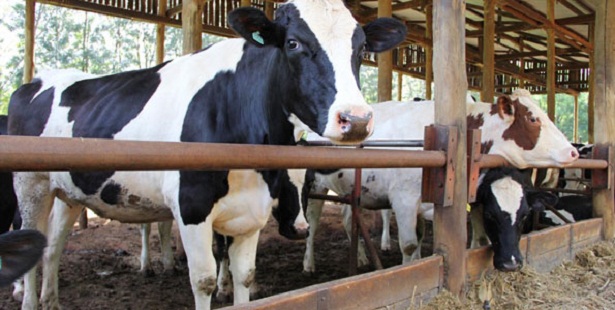Heifers of pure exotic breeds should give birth by 24 months from the day they were born. This means they should have been pregnant by 15 months of age. Older cows should get pregnant by 85 days after the previous calving if the cows are to give you a calf every year and maximise on milk yield.
To achieve this, the farmer has to invest in confirming that each of her heifers and cows will attain these targets by first ensuring the animals are fed with the recommended balanced diets and secondly ensure the animals are free of conditions that can interfere with heat signs (cycling) and conception. The 24 months and 85 days are important because research has shown that a cow will be able to give its maximum milk potential and calves if these standards are maintained. Therefore, confirm your heifer is cycling properly before 15 months of age and start it on Artificial Insemination (AI) at about 14 months.
For the older cows, start cycling as early as 24 days after last calving so confirm they are cycling before day 50 after calving by which time about 95 per cent of the animals will have started cycling and you can start the cows on AI. If no signs are seen for both heifers and cows despite all efforts, you need to invite a vet to check the status of the ovaries as soon as possible. The vet may find the cow’s ovary is showing signs of egg growth but the farmer has not been able to observe the heat signs or that there are no eggs growing. The vet will advice on which day AI should be given in the former case. The solution for the latter is to inject the correct hormone to kick start the growth of an egg in which case the animal can then be given AI.
On the other hand, the vet may find the egg may be present and mature but the ovary is unable to release it in which case the vet will give it the correct hormone to cause the release of the egg followed by AI.
Other conditions that may cause the farmer to miss getting a cow pregnant is a reproductive track that is infected. This infection may be from problems associated with the previous calving such as difficult calving and/ or retained after birth (placenta). Forcefully pulling obstructed calves will result in reproductive track injuries resulting in infections that will cost you a lot of money to treat and the loss of milk production during recovery. It is much cheaper to call a professional to deal with it promptly.
The reproductive tract can also get infected from previous encounters with diseased bulls. This is a common problem in Kenyan herds when farmers take their cows to communal or neighbours or own bulls of unknown disease status for natural service whereupon they become infected with venereal diseases that infect the reproductive system of the cow resulting in no conception.
When to call a vet The farmers then try the AI which fails. Some venereal diseases can take months to get resolved and for the animal to regain its fertility. So farmers be warned: stick to AI alone! And if you must use a bull (even an own bull ) it should be known to be free of diseases that affect reproduction. Animals that are not well fed or have hormonal imbalances will have a problem with releasing the afterbirth (placenta).
It should drop off by five hours after calving and if not a vet should examine it as soon as possible to determine the best action in each specific case to avoid the infection of the reproductive tract which will occur within the second day. Serious infections can be seen as pus drooping from the back of the animal, again it is much cheaper to call a vet to deal with it within 24 hours after calving.
High fever from diseases like East Coast Fever, anaplasmosis and heavy infestations with worms like flukes, lack of protein, energy and mineral salts can cause growing embryos to die. The solution to many of these is to take prompt proactive actions that will prevent them from occurring such as spraying, deworming and feeding your animals effectively. Have your heifers also examined for breeding fitness to identify congenital abnormalities like kinked cervixes.








